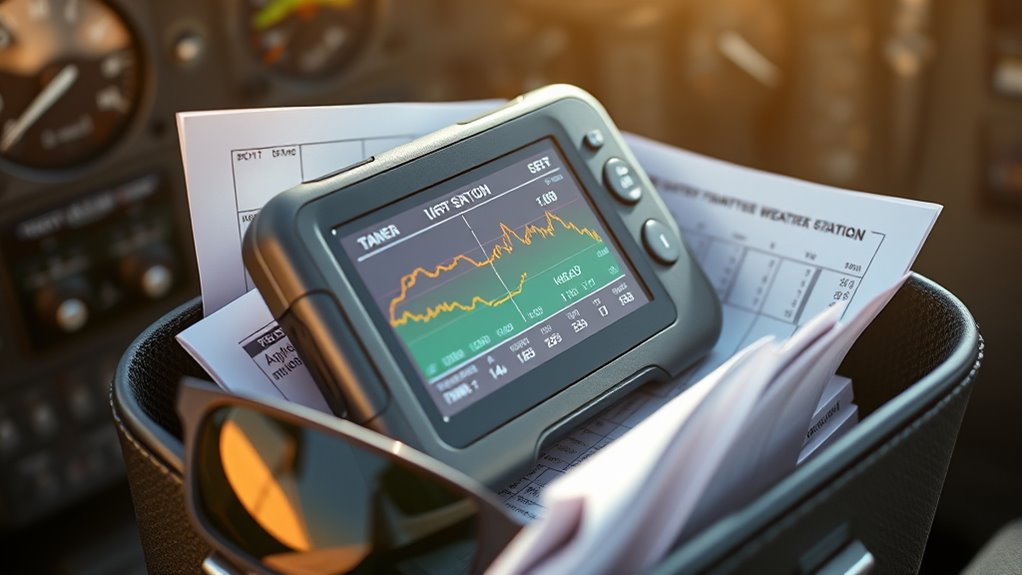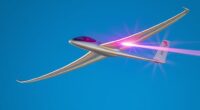As a pilot, I know how vital up-to-date, hyper-local weather info is for safety. The top portable weather stations, like Tempest, Ambient Weather models, and AcuRite, offer real-time readings of wind, rain, temperature, and humidity, often with Wi-Fi or Alexa integration. They’re durable, portable, and designed to give quick, reliable data on the go. If you keep exploring, you’ll find key features and tips to choose the best one for your needs.
Key Takeaways
- Prioritize models with hyper-local, real-time wind, temperature, and barometric data crucial for pre-flight safety.
- Choose weather stations with portable, rugged designs suitable for outdoor and aviation environments.
- Ensure devices support reliable wireless connectivity and integration with aviation or weather-sharing platforms.
- Opt for high-precision sensors with calibration options to maintain accuracy in variable outdoor conditions.
- Consider features like lightning detection, UV sensors, and large, easy-to-read displays for quick, informed decision-making.
Tempest Weather System with Wind Meter, Rain Gauge & Alexa

If you’re a pilot who needs reliable, real-time weather data, the Tempest Weather System is an excellent choice. It combines a built-in wind meter, rain gauge, and accurate forecasts into a single device, trusted by experts and featured in top publications. With over 85,000 users, it provides hyper-local data on temperature, humidity, barometric pressure, wind, rainfall, and more, updating every 3 seconds via a solar-powered sensor. Easy to install and maintain, it wirelessly transmits data up to 1,000 feet and integrates seamlessly with Alexa and other smart platforms. Its precise measurements and user-friendly app make it an invaluable tool for safe flying.
Best For: pilots and aviation enthusiasts who require precise, real-time weather data for safe flying and flight planning.
Pros:
- Provides hyper-local, highly accurate weather measurements including wind speed, direction, and rainfall.
- Seamless integration with Alexa and smart home platforms for automation and alerts.
- Easy installation with minimal maintenance, thanks to solar power and wireless transmission.
Cons:
- Premium price may be a barrier for some users.
- Occasional reports of outliers or accuracy issues, particularly with wind and rain direction.
- Durability concerns noted by some users after extended use, potentially affecting long-term reliability.
Ambient Weather WS-2902 WiFi Smart Weather Station
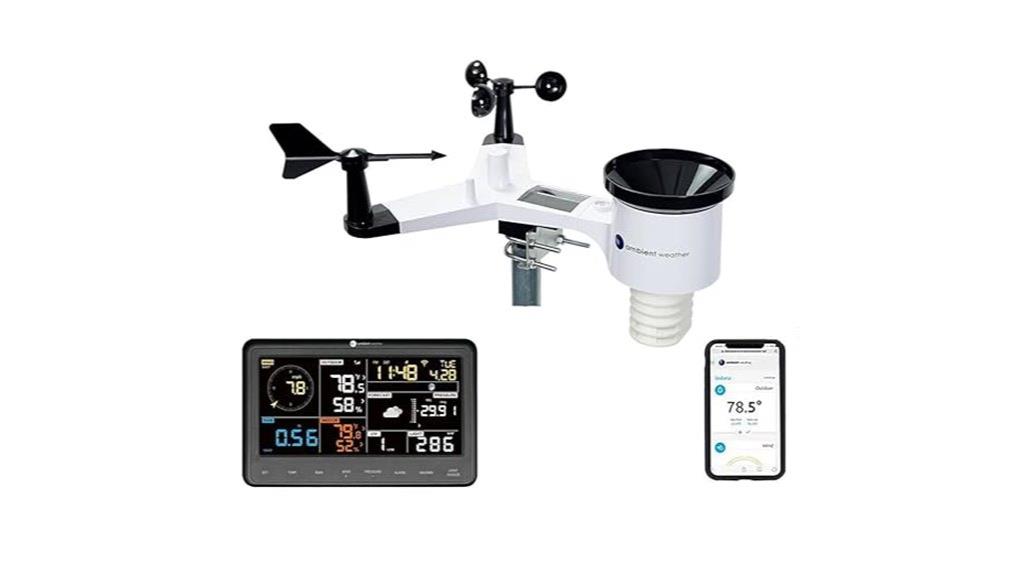
The Ambient Weather WS-2902 WiFi Smart Weather Station stands out for its extensive sensor array and easy wireless connectivity, making it an excellent choice for pilots who want hyper-local, real-time weather data. It measures wind speed and direction, temperature, humidity, rainfall, UV, and solar radiation, delivering accurate readings. Setup is quick—about five minutes with a simple pole mount—and the color LCD display is clear and easy to read. It connects wirelessly via Wi-Fi, supporting integration with Ambient Weather, IFTTT, Google Home, and Alexa. Data uploads reliably, providing timely updates perfect for staying informed during flights or pre-flight planning.
Best For: Pilots and aviation enthusiasts seeking hyper-local, real-time weather data for flight safety and planning.
Pros:
- Comprehensive sensor array measuring wind, temperature, humidity, rainfall, UV, and solar radiation for accurate, hyper-local weather insights
- Easy setup with a quick five-minute installation and a clear, readable color LCD display
- Reliable wireless Wi-Fi connectivity supporting integration with Ambient Weather, IFTTT, Google Home, and Alexa for seamless data access and automation
Cons:
- Requires Wi-Fi with disabled AP isolation; some routers may need extenders for optimal performance
- Weather Underground data uploads can experience technical issues, leading to occasional data gaps
- Privacy settings limit the ability to publicly share weather data without logging into the platform
Ambient Weather WS-1965 WiFi Weather Station
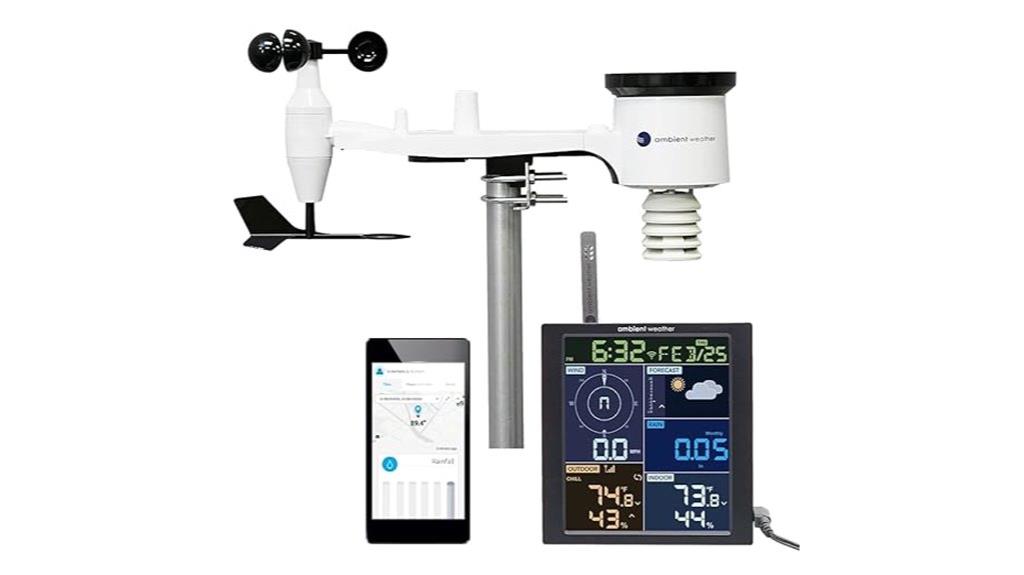
For pilots seeking reliable, real-time weather data at home or on the go, the Ambient Weather WS-1965 WiFi Weather Station stands out thanks to its seamless WiFi connectivity and community-sharing features. It provides accurate measurements of temperature, humidity, wind speed, wind direction, rainfall, and barometric pressure with updates every 16 seconds. The color LCD display is clear and easy to read, and setup is straightforward—mostly involving WiFi configuration via a web browser. Data can be shared on the Ambient Weather Network, enabling community comparisons and forecast customization. Optional add-ons like lightning detection and soil moisture sensors expand its functionality, making it a versatile tool for serious weather enthusiasts.
Best For: weather enthusiasts, hobbyists, and pilots seeking reliable, accurate real-time weather data with community sharing capabilities.
Pros:
- Highly accurate measurements of temperature, wind, and barometric pressure with quick updates
- Easy setup via WiFi with web browser configuration, and robust, clear display
- Expandable with optional sensors like lightning detection and soil moisture for added versatility
Cons:
- WiFi setup can be fiddly and may require technical support
- Lacks solar panel option, which could extend battery life and add UV or solar radiation measurement
- Subscription fees may be necessary for advanced graphing features and detailed data access
Ambient Weather WS-5000 Ultrasonic Smart Weather Station
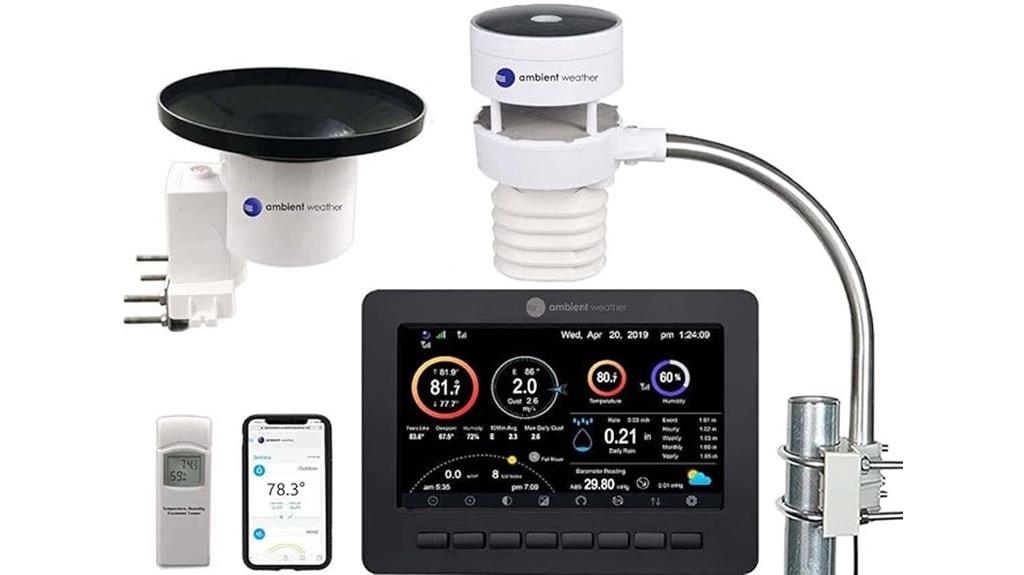
Pilots seeking precise, real-time weather data will find the Ambient Weather WS-5000 Ultrasonic Smart Weather Station an excellent choice. Its all-in-one ultrasonic sensor measures wind speed and direction without moving parts, providing fast setup and updates every five seconds. The station includes a rain cup and indoor/outdoor thermo-hygrometer-barometer, plus a vibrant TFT full-color LCD display for easy reading. It supports wireless data sharing via enhanced Wi-Fi, integrating seamlessly with smart home systems like Alexa, Google Home, and IFTTT. Connecting to Ambient Weather Network, you can customize dashboards, share hyperlocal conditions, and access broader community data — perfect for staying informed on the go.
Best For: pilots and weather enthusiasts seeking precise, real-time weather updates with smart home connectivity and community sharing capabilities.
Pros:
- Ultrasonic sensor measures wind speed and direction without moving parts for enhanced durability and quick setup.
- Provides updates every five seconds, ensuring highly accurate and current weather data.
- Supports seamless integration with smart home devices like Alexa, Google Home, and IFTTT for automation and alerts.
Cons:
- Requires Wi-Fi connectivity for full functionality, which may be limited in remote locations.
- The setup may be complex for users unfamiliar with smart home systems or network configurations.
- Cost may be higher compared to basic weather stations lacking smart features and community sharing options.
Sainlogic Portable Weather Station SA3 with WiFi Thermometer Hygrometer
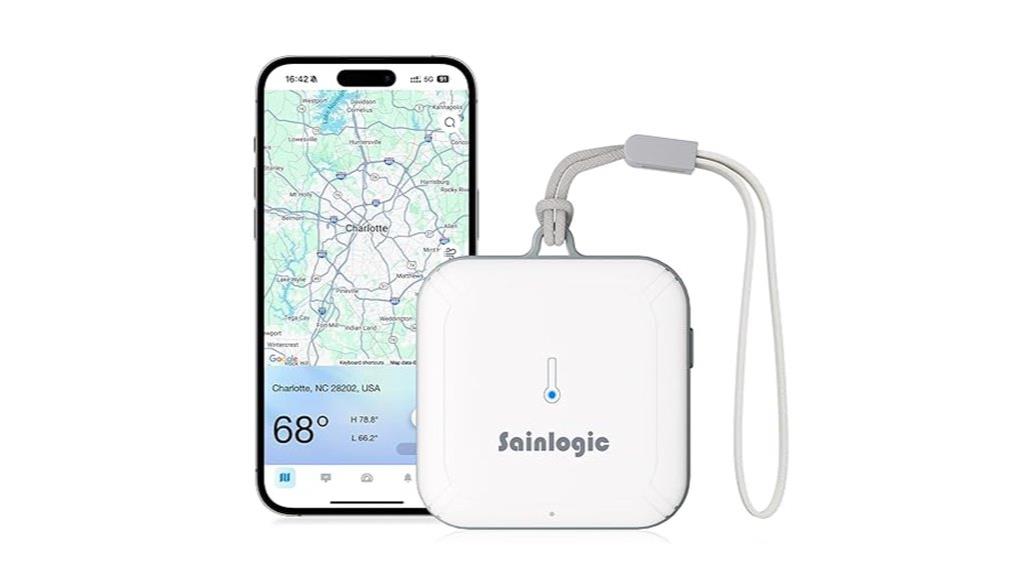
If you’re looking for a reliable portable weather station that offers real-time environmental data, the Sainlogic SA3 stands out as an excellent choice for indoor and greenhouse monitoring. It provides accurate temperature, humidity, and barometric pressure readings via WiFi and Bluetooth, making remote access easy through the Weatherseed app. Its compact, lightweight design includes a lanyard loop for versatile placement, whether in greenhouses, rooms, or wine cellars. While not fully weatherproof, it’s ideal for covered environments. With support for 2.4G WiFi, customizable alerts, and data storage for up to two years, it’s a practical tool for precise climate management.
Best For: indoor and greenhouse enthusiasts seeking accurate, remote environmental monitoring with easy setup and long-term data storage.
Pros:
- Supports real-time temperature, humidity, and pressure monitoring via WiFi and Bluetooth.
- Compact, lightweight design with versatile mounting options, including a lanyard loop.
- Stores up to two years of data with export options for detailed climate analysis.
Cons:
- Not fully weatherproof, best used in covered or indoor environments.
- Does not support 5G WiFi networks, limiting connectivity options in some areas.
- Limited outdoor weather data, as it does not track wind or rain.
Sainlogic Wireless Weather Station with Outdoor Sensor
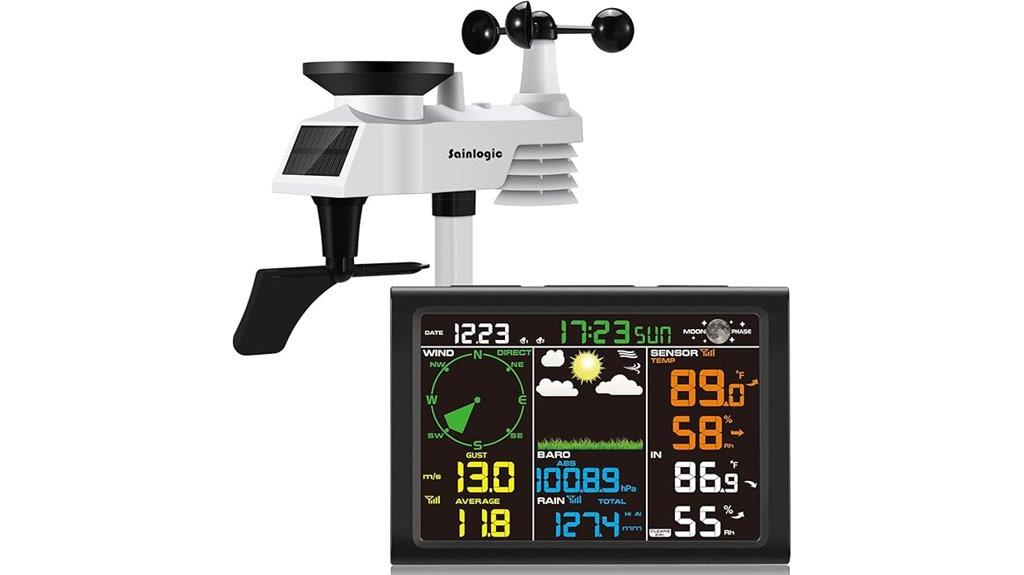
The Sainlogic Wireless Weather Station with Outdoor Sensor stands out for its all-encompassing real-time weather monitoring, making it an excellent choice for outdoor enthusiasts and professionals who need accurate, immediate data. It tracks rainfall, wind speed and direction, air pressure, humidity, and temperatures both indoors and outdoors, with a moon phase display. The large LCD with adjustable backlight guarantees easy reading, while wireless transmission up to 328 feet maintains reliable data transfer. Although humidity readings outdoors may vary, and the rain gauge isn’t always precise, the station’s straightforward setup and detailed alerts make it a versatile tool for weather tracking and outdoor planning.
Best For: outdoor enthusiasts, hobbyists, and professionals who require accurate, real-time weather data for gardening, outdoor activities, or planning.
Pros:
- Comprehensive real-time weather monitoring including rainfall, wind, pressure, and temperature readings
- Large, easy-to-read LCD display with adjustable backlight and color-coded sections
- Reliable wireless transmission up to 328 feet, supporting easy installation and use
Cons:
- Humidity readings outdoors may vary, affecting data accuracy
- Rain gauge may not record rainfall accurately at all times
- Lacks WiFi or app connectivity for remote monitoring and smart home integration
Weather Station Wireless Indoor/Outdoor with 9-in-1 Sensor & LCD Display

Designed for those who need reliable, real-time weather data both indoors and outdoors, the Weather Station Wireless Indoor/Outdoor with 9-in-1 Sensor & LCD Display offers precise measurements that pilots can depend on. Its outdoor sensor measures temperature, humidity, wind speed, and rainfall with high accuracy, matching nearby forecasts and airport data closely. The sensor’s range extends up to 328 feet, providing flexible placement. The large LCD console displays critical info like wind, pressure, dew point, and moon phase, updating every 16 seconds. With easy setup and calibration options, it’s a practical choice, though some users note calibration challenges and occasional discrepancies in outdoor readings.
Best For: outdoor enthusiasts, pilots, and homeowners seeking accurate, real-time weather data for personal or professional use.
Pros:
- Provides precise indoor and outdoor weather measurements with calibration options for enhanced accuracy
- Long-range outdoor sensor (up to 328 feet) allows flexible placement across large areas
- Large, bright LCD display offers comprehensive weather information with easy-to-read visuals
Cons:
- Users report calibration challenges, particularly with outdoor temperature and humidity readings
- Some units experience discrepancies between actual and displayed outdoor measurements
- Limited long-term reliability and customer support issues due to quality control concerns
Ambient Weather WM-5 Handheld Weather Meter
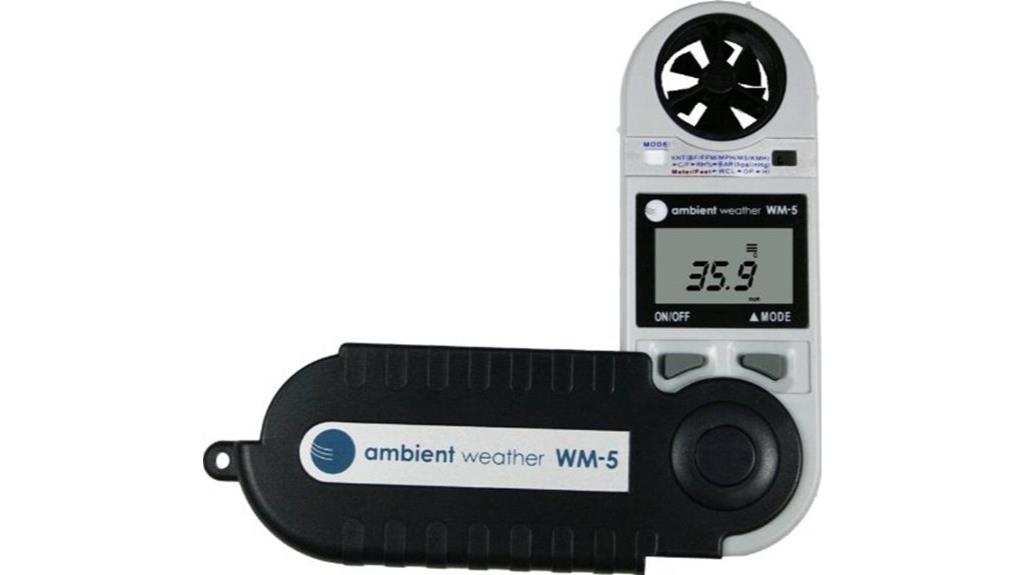
For pilots needing a reliable, portable weather tool, the Ambient Weather WM-5 Handheld Weather Meter stands out with its all-encompassing measurements and compact design. It’s lightweight at about 4 ounces, making it easy to carry during outdoor flights or pre-flight checks. It measures wind speed, temperature, humidity, dew point, pressure, and altitude, providing critical data on the go. The device is water-resistant, floats, and includes a flashlight for low-light conditions. While it offers detailed readings, calibration is essential for accuracy, and small display characters can be challenging to read in dim light. Overall, it’s a versatile tool for pilots and outdoor enthusiasts alike.
Best For: outdoor enthusiasts, weather professionals, and pilots needing portable, comprehensive weather data during outdoor activities or pre-flight checks.
Pros:
- Offers extensive weather measurements including wind speed, temperature, humidity, dew point, pressure, and altitude.
- Compact, lightweight, and water-resistant, ideal for outdoor use and easy to carry.
- Includes useful features such as a flashlight, neck lanyard, and a protective case, enhancing usability in various conditions.
Cons:
- Small display characters can be difficult to read, especially in low light conditions.
- Requires careful calibration for accurate measurements, particularly after changing locations or elevations.
- Battery life is limited, with some users experiencing higher-than-expected consumption, necessitating spare batteries.
Weather Station Wireless Indoor/Outdoor Thermometer and Barometer
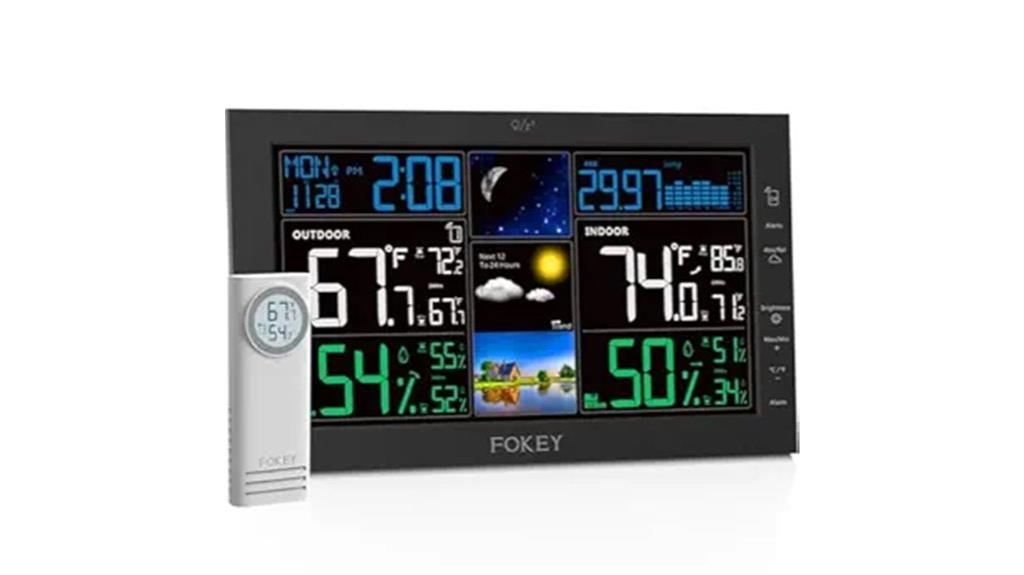
If you want reliable, real-time environmental data to make smarter flying decisions, the Weather Station Wireless Indoor/Outdoor Thermometer and Barometer is an excellent choice. Its 7.6 VA LCD display offers clear, adjustable brightness, showing temperature, humidity, barometric pressure, weather forecast, moon phases, and time—all from across the room. Engineered with a thermal-stabilized chip, it provides high-precision readings with a margin of just ±0.48°F. The remote sensor has a 328-foot wireless range, is weather-resistant, and suitable for outdoor placement. With automatic atomic clock synchronization and multiple display options, this station delivers extensive, accurate data to help pilots stay informed wherever they are.
Best For: weather enthusiasts, pilots, and homeowners seeking accurate, real-time environmental data for outdoor and indoor conditions.
Pros:
- High-precision measurements with a thermal-stabilized chip, ±0.48°F accuracy
- Wireless remote sensor with a 328-foot range, weather-resistant for outdoor use
- Automatic atomic clock synchronization and multiple display options for convenience
Cons:
- Sensors require placement in dry, shaded areas for optimal accuracy
- Setup may be challenging for users unfamiliar with electronic devices
- Display brightness adjustments may not be sufficient for very bright environments
Newentor Wireless Weather Station with Color Display
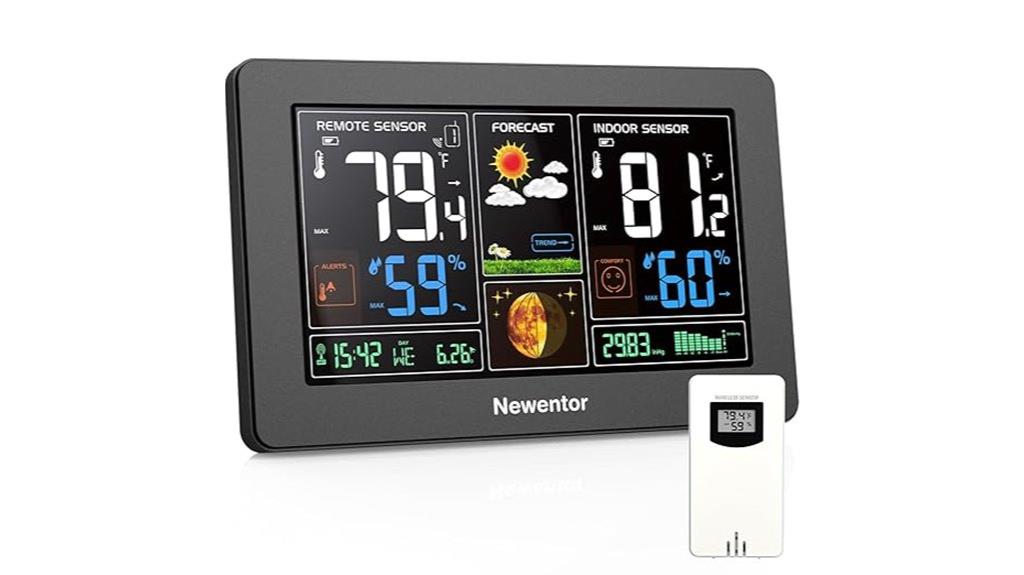
The Newentor Wireless Weather Station with Color Display stands out with its vibrant 7.5-inch LCD screen that provides a clear, all-encompassing overview of both indoor and outdoor conditions. It displays temperature, humidity, weather forecasts, moon phases, barometric pressure, and time with customizable alerts and adjustable backlight. The station supports up to three remote sensors, allowing me to monitor multiple locations within a 100-foot range. Setup is straightforward, and the device offers reliable, real-time data. Its bright, colorful display is viewable from various angles, making it easy to read from a distance. Overall, it’s a versatile, user-friendly tool for staying informed on the go.
Best For: weather enthusiasts, outdoor adventurers, and homeowners seeking accurate, comprehensive indoor and outdoor weather monitoring with a vibrant display.
Pros:
- Bright, customizable 7.5-inch color LCD display with easy-to-read data from various angles
- Supports up to three remote sensors for monitoring multiple locations within approximately 100 feet
- Accurate weather forecasting with calibration options and reliable real-time updates
Cons:
- Small font size for time and date may be hard to read for some users
- Sensors can experience signal loss or accuracy issues in extreme cold (around 20°F or below)
- Requires proper placement and protection of outdoor sensors to ensure longevity and accuracy
ECOWITT Wittboy Pro Weather Station with 7-Inch TFT Display and Outdoor Sensor
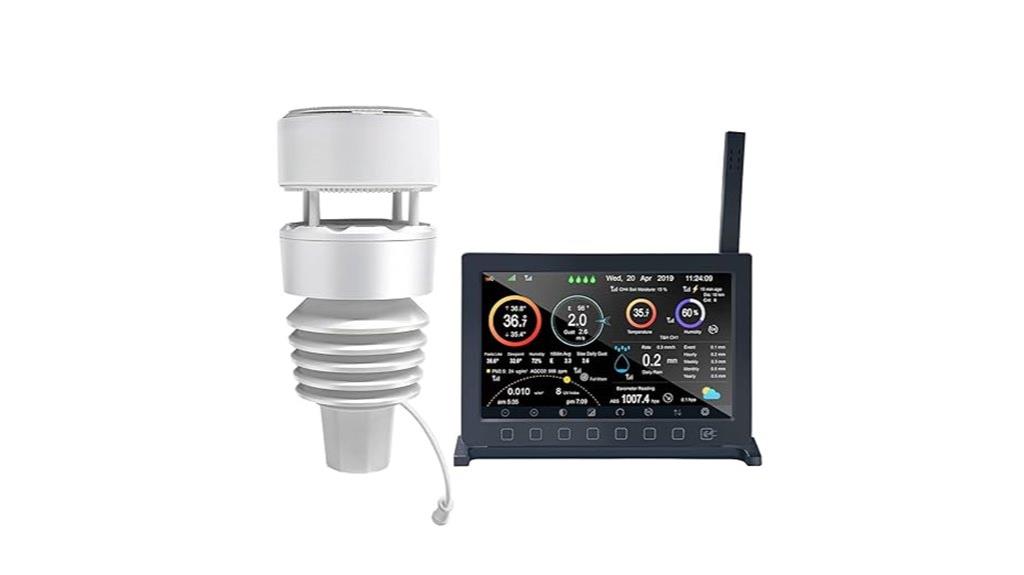
The ECOWITT Wittboy Pro Weather Station stands out as an excellent choice for pilots who need accurate, real-time weather data on the go. Its 7-inch TFT display offers clear, easy-to-read information, while the all-in-one outdoor sensor delivers precise measurements of temperature, humidity, wind speed and direction, UV levels, rainfall, and light. Built with durability in mind, it’s waterproof and solar-powered, making it suitable for various climates. Its Wi-Fi connectivity allows seamless data sharing with weather platforms and smart home systems. Though some measurements may drift over time, calibration helps maintain accuracy. Overall, it’s a robust, feature-rich weather station perfect for pilots seeking reliable, portable weather insights.
Best For: pilots and outdoor enthusiasts who require accurate, real-time weather data in various environments.
Pros:
- Provides comprehensive weather measurements including wind, rain, UV, and light with high precision.
- Durable, waterproof design with solar power and backup batteries ensures reliable operation outdoors.
- Easy Wi-Fi connectivity allows seamless data sharing with weather platforms and smart home systems.
Cons:
- Some measurements like wind speed and rainfall may experience minor drift over time, requiring calibration.
- Initial setup and calibration can be time-consuming and may require manual adjustments.
- Repairing or replacing individual sensor components can be challenging if a failure occurs.
Sainlogic Wireless Weather Station with Outdoor Sensor
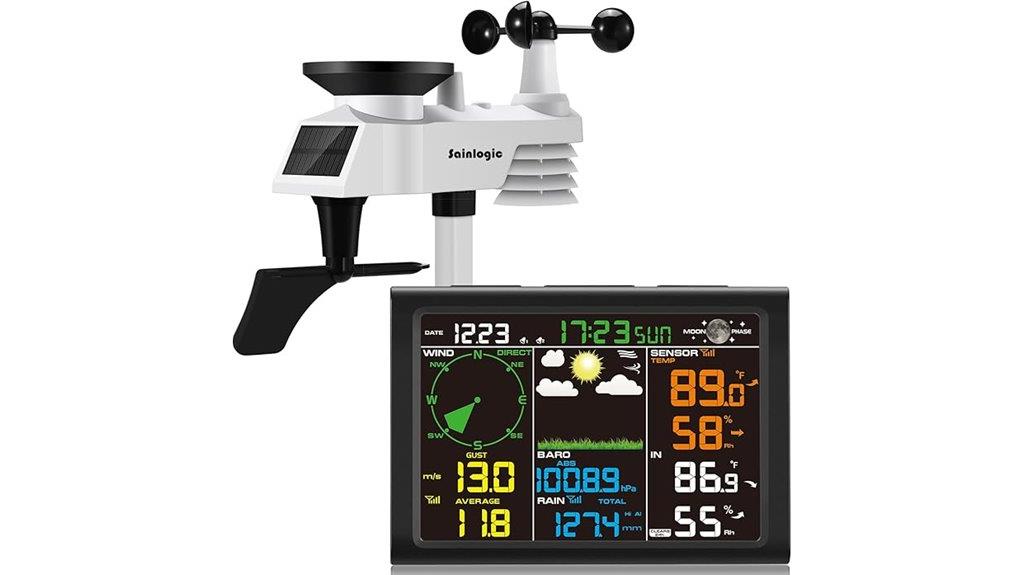
For pilots who need reliable, real-time weather data without complicated setup, the Sainlogic Wireless Weather Station with Outdoor Sensor stands out as an excellent choice. It offers extensive monitoring of rainfall, wind speed and direction, air pressure, humidity, and indoor/outdoor temperatures, all with impressive accuracy. The large LCD display is easy to read, with adjustable backlighting and color-coded sections. Installation is simple—outdoor sensors can be mounted on poles or rooftops, and wireless transmission covers up to 328 feet. While it lacks WiFi or app connectivity, its reliable data and alerts make it perfect for on-the-go weather tracking, especially in remote or outdoor environments.
Best For: pilots and outdoor enthusiasts who require reliable, real-time weather data without the need for complicated setup or smart device connectivity.
Pros:
- Accurate monitoring of rainfall, wind, pressure, humidity, and temperature with large, easy-to-read display.
- Simple installation with wireless transmission up to 328 feet, ideal for remote or outdoor environments.
- User-friendly interface with customizable alerts and adjustable backlight for easy visibility.
Cons:
- Lacks WiFi or app connectivity, limiting remote access to data.
- Humidity readings outdoors may vary, and the rain gauge might not record accurately.
- Battery-powered outdoor sensor requires regular replacements and does not recharge via solar power.
Urageuxy Wireless WiFi Weather Station with Anemometer and Indoor/Outdoor Thermometer
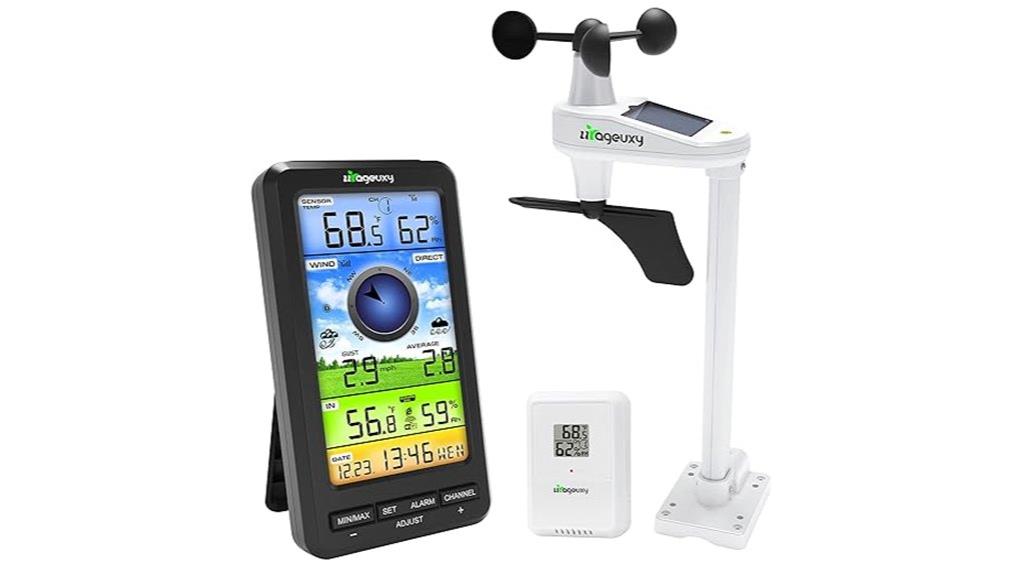
If you’re looking for a weather station that offers extensive data sharing and remote monitoring, the Urageuxy Wireless WiFi Weather Station stands out. It combines multiple sensors, including wind speed, wind direction, indoor and outdoor thermometers, and humidity, all accessible via WiFi. It uploads real-time data to platforms like Weather Underground, allowing you to monitor conditions remotely. The bright 5-inch color display is easy to read, and setup is straightforward. However, some users report inconsistent wind readings and confusing display icons. Despite these issues, it’s a versatile option for pilots needing detailed weather info and remote access in one device.
Best For: outdoor enthusiasts, farmers, and homeowners needing comprehensive remote weather monitoring and data sharing capabilities.
Pros:
- Supports wireless data upload to popular weather platforms like Weather Underground for remote access
- Features a bright, easy-to-read 5-inch color display suitable for day and night viewing
- Includes multiple sensors for wind speed, wind direction, indoor/outdoor temperature, and humidity
Cons:
- Wind speed and direction readings can be inconsistent and slow to refresh, affecting real-time accuracy
- Display icons can be confusing, such as fixed sun/cloud symbols that obscure data
- Not truly solar-powered; solar cells do not recharge batteries, and indoor temperature calibration may be necessary
AcuRite Atlas Weather Station with Wi-Fi Display and Weather Measurements
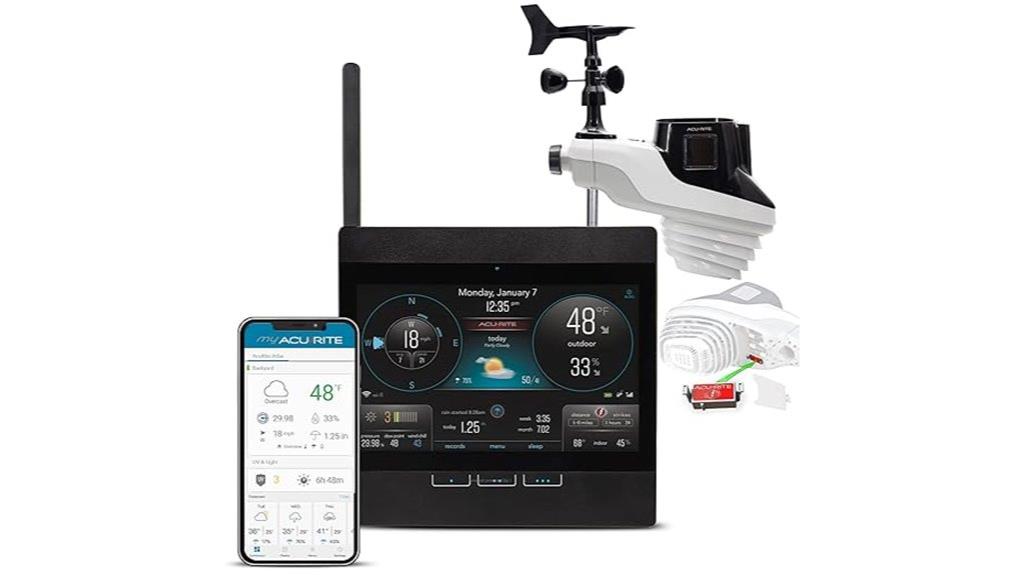
AcuRite Atlas Weather Station stands out for pilots who need hyperlocal, real-time weather data with lightning detection capabilities. I find its sensors measuring indoor and outdoor temperature, humidity, wind speed, direction, barometric pressure, rainfall, UV, and light intensity impressive. The wireless outdoor sensor and high-def display make monitoring easy, even from multiple angles. Its lightning detection up to 25 miles adds storm safety. With Wi-Fi connectivity, I can access live updates via the My AcuRite app and Weather Underground, sharing data with a global community. Despite some connectivity issues and outdated hardware, it remains a detailed tool for pilots seeking detailed, real-time weather information on the go.
Best For: pilots and storm chasers who need comprehensive, real-time hyperlocal weather data with lightning detection capabilities.
Pros:
- Offers detailed measurements of indoor/outdoor temperature, humidity, wind, pressure, rainfall, UV, and light intensity.
- Includes lightning detection up to 25 miles, enhancing storm safety.
- Connects via Wi-Fi for remote access through the My AcuRite app and Weather Underground, facilitating data sharing and real-time updates.
Cons:
- Frequent Wi-Fi connectivity issues and device dropouts can hinder reliable operation.
- Outdated hardware with low-resolution, non-touch TFT display limits user experience.
- Setup process is cumbersome and may be incompatible with newer routers or dual-band networks.
WiFi Weather Station with Indoor/Outdoor Thermometer and Rain Gauge

The WiFi Weather Station with Indoor/Outdoor Thermometer and Rain Gauge stands out with its ultra-large 7.5-inch HD display, making it easy to read critical weather data at a glance. Its intuitive interface shows real-time temperature, humidity, wind speed, rainfall, pressure, UV index, and forecasts, all adjustable for day or night visibility. Connects seamlessly via WiFi to a smartphone app for remote monitoring and customization. The professional-grade sensors provide accurate data on wind, rain, and air quality over distances up to 328 feet. Powered by AC, solar, or batteries, it’s perfect for outdoor or indoor use, offering reliable, all-encompassing weather info for pilots and outdoor enthusiasts alike.
Best For: outdoor enthusiasts, gardeners, and weather hobbyists seeking accurate, professional-grade weather monitoring with a large, easy-to-read display.
Pros:
- Ultra-large 7.5-inch HD VA screen with adjustable brightness for clear visibility day or night
- Seamless WiFi connection to smartphone app for remote data access and customization
- Professional-grade sensors with up to 328 feet transmission range for precise outdoor weather measurements
Cons:
- WiFi functionality requires continuous power; no connection on battery alone
- Batteries for sensors are not included, adding extra initial setup cost
- External sensors may take about 15 minutes to install and calibrate outdoors
Factors to Consider When Choosing Portable Weather Stations for Pilots
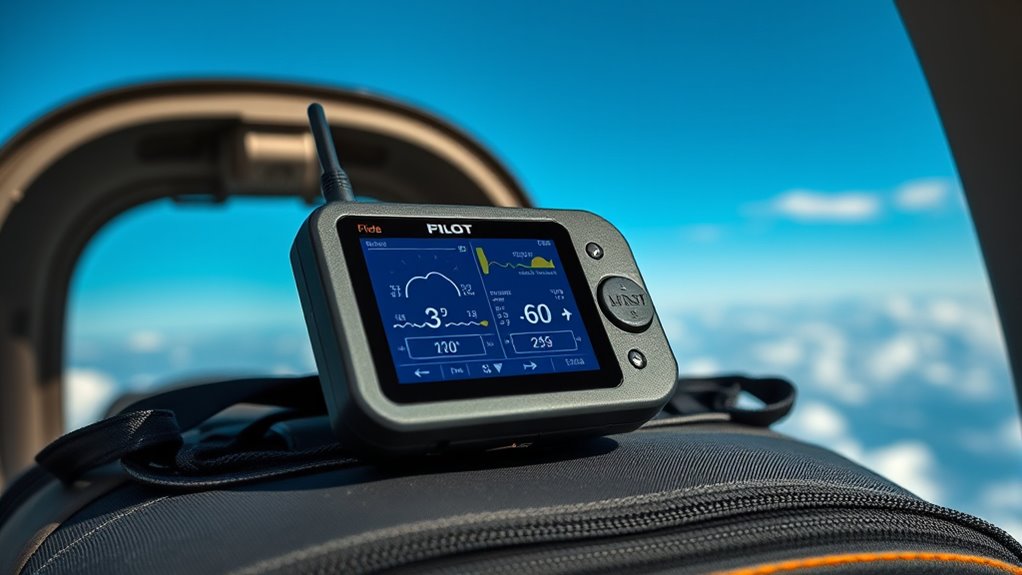
When selecting a portable weather station, I focus on several key factors to ensure it meets my flying needs. I look for high measurement accuracy, easy portability, and reliable connectivity options that keep data accessible. Durability and data integration are also vital to withstand weather conditions and seamlessly fit into my flight planning.
Measurement Accuracy Standards
Choosing a portable weather station for pilots hinges on its measurement accuracy, which must meet industry standards to guarantee reliable data. Accurate temperature readings should be within ±0.5°F, while humidity measurements should stay within ±3%. Wind speed sensors need to be precise to within 1-2 mph, ensuring safe and informed decisions. High-quality sensors are essential to detect subtle atmospheric changes that impact safety. Calibration procedures, established by manufacturers, help maintain these accuracy levels over time and in varying conditions. Additionally, compliance with recognized standards like those from the National Weather Service or ISO indicates the device’s reliability. Regular validation against professional-grade equipment or official weather data sources is also recommended to ensure ongoing measurement accuracy, so you can trust the data when it matters most.
Portability and Ease
Selecting a portable weather station that’s easy to carry and operate makes a significant difference for pilots on the move. I look for lightweight, compact units that fit easily in my gear, allowing quick setup in any environment. User-friendly interfaces with straightforward controls help me get instant readings without fuss, which is essential during pre-flight checks. Battery life matters too—many models offer rechargeable or long-lasting power to keep the device reliable during extended flights. Size and weight must comply with aircraft space constraints, so portability isn’t just convenience but a necessity. Features like quick assembly, minimal calibration, and rugged construction ensure the station withstands diverse weather conditions and stays easy to use. In short, portability and ease of use are indispensable for staying informed efficiently and safely.
Connectivity Options
Ensuring reliable connectivity is essential for portable weather stations used by pilots, as it guarantees real-time data access in diverse environments. I look for devices that support multiple options like Wi-Fi, Bluetooth, and cellular networks, ensuring I stay connected whether on the ground or in the air. Seamless integration with smartphones, tablets, or cockpit displays via apps or direct connections is a must, providing instant weather updates. Dual-mode connectivity, switching between Wi-Fi and Bluetooth, helps maintain data flow during network disruptions. Compatibility with standard protocols like NMEA or AMQP allows smooth integration with existing avionics and navigation systems. Additionally, secure data encryption and failover mechanisms are critical to prevent data loss during signal interruptions, keeping me informed and safe throughout my flights.
Durability and Weatherproofing
When evaluating portable weather stations for piloting, durability and weatherproofing stand out as top priorities. I look for devices with an IP65 rating or higher, guaranteeing they resist dust and water intrusion in tough conditions. Features like sealed enclosures, corrosion-resistant materials, and rubber gaskets protect against rain, snow, and humidity, extending the device’s lifespan. UV-resistant plastics and coatings are essential for outdoor use, preventing damage from prolonged sunlight. A robust build with shock-absorbing parts helps withstand impacts and rough handling during transport and outdoor deployment. Additionally, I consider temperature tolerance, preferring stations that operate reliably between -40°F and 140°F. These features ensure the weather station remains accurate and functional, no matter the environment, providing reliable data when I need it most.
Data Integration Capabilities
Effective data integration capabilities are essential for portable weather stations, as they allow seamless connections with various smart home platforms, weather services, and automation systems. This integration enhances real-time decision-making by providing timely, accurate weather data. Compatibility with protocols like IFTTT, Weather Underground, or custom APIs enables me to aggregate information from multiple sources and customize alerts based on specific conditions. The ability to export data in standard formats such as CSV or JSON simplifies analysis and helps maintain detailed records for flight planning. Advanced stations support firmware updates and API access, ensuring ongoing compatibility and security. Reliable synchronization and minimal latency are vital for receiving immediate weather insights during pre-flight checks or in-flight adjustments, ultimately boosting safety and operational efficiency.
Power Source Flexibility
Choosing the right power sources for a portable weather station can considerably impact its reliability during flights. I look for devices that offer multiple options like rechargeable batteries, solar panels, or AC adapters. This flexibility guarantees I can keep the station operational in remote areas, long flights, or during power outages. Low power consumption is also essential, as it extends battery life and reduces the need for frequent recharging. Compatibility with portable or rechargeable power packs adds to the station’s versatility, especially when traditional outlets aren’t available. Adjustable power settings allow me to optimize energy use based on flight duration and environmental conditions. Ultimately, a weather station with flexible, efficient power options keeps me informed and safe, no matter where my journey takes me.
Frequently Asked Questions
How Accurate Are Portable Weather Stations for Aviation Use?
Portable weather stations for aviation are quite accurate, especially when you choose high-quality models with certified sensors. I’ve found that they provide reliable data on wind speed, temperature, and barometric pressure, which helps me make informed decisions. However, I always cross-check with official weather reports before flying. While not perfect, a good portable station enhances safety and situational awareness, giving me confidence during pre-flight planning and in-flight adjustments.
Do These Stations Work Reliably in Extreme Weather Conditions?
Oh, absolutely, these stations are indestructible, right? In reality, I’ve found that most portable weather stations, while useful, can struggle in extreme weather. High winds, heavy rain, or snow might give them a hard time, leading to less reliable readings. I always recommend having backup methods and knowing their limitations before trusting them entirely when Mother Nature throws a tantrum. Safety first, after all!
Can the Devices Interface With In-Flight Navigation Systems?
Yes, many portable weather stations can interface with in-flight navigation systems, but it depends on the model. I’ve found that advanced devices with Bluetooth or Wi-Fi capabilities often sync with cockpit systems, providing real-time updates. However, I always double-check compatibility beforehand. It’s essential to choose a weather station that’s designed for aviation use, ensuring seamless integration and reliable data transfer during flights.
What Is the Battery Life of These Portable Weather Stations?
Ever wondered how long these weather stations last? Typically, they offer a battery life between 8 to 12 hours on a full charge, depending on usage and features. I find this range quite sufficient for most flights, but it’s smart to carry a portable charger for extended trips. This way, I stay informed and safe without worrying about running out of power mid-flight.
Are These Weather Stations Approved or Recommended for Professional Pilot Use?
Yes, many portable weather stations are approved or recommended for professional pilot use. I always look for models that meet aviation standards and have certifications from relevant authorities, like FAA or EASA. These devices are designed with high accuracy and reliability in mind, so I trust them during flights. However, I recommend double-checking each model’s certifications and consulting with aviation professionals before relying on them for critical decisions.
Conclusion
Choosing the right portable weather station is like holding a compass in your hands—guiding you safely through unpredictable skies. Each device is a beacon, illuminating the path ahead and helping you read the weather’s silent language. Stay informed, stay prepared, and trust these tools to be your loyal guide in the ever-changing skies. After all, when you’re flying high, a reliable weather station is the steady star that keeps you on course.
With a heart that soars as high as the skies, Aria, affectionately known as “Skylark,” is the driving force behind Soaring Skyways. Her journey into the gliding world began as a young dreamer gazing up at the soaring birds, yearning to experience the weightlessness and freedom they embodied. With years of experience both in the cockpit and behind the scenes, Aria’s commitment to the gliding community is unwavering.
